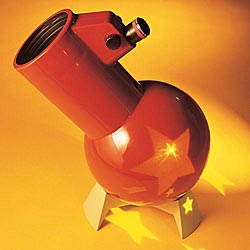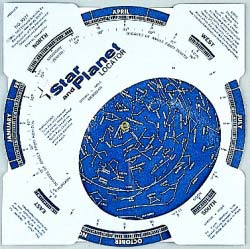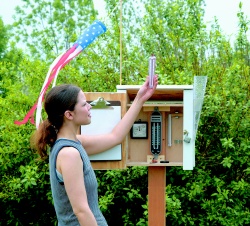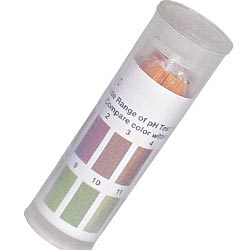Brains enjoy getting information about the world around them. Although our sense organs do a pretty good job of keeping the data flowing to the brain, the occasional sense-organ-extending measuring device can add a whole new set of experiences for our brains to chew on.
We wrap up the brain-friendly giftables list with a selection of measuring devices. A (lab) notebook or sketch pad would make a fine accompaniment to any of these.

Hands-down, this was the most recommended giftable measuring device, and I don’t think this is just a matter of ScienceBlogs skewing heavily toward the life sciences. Looking at tiny little things with a lens that can show you all kinds of detail is cool. There are loads of different microscopes on the market, ranging from good student models under $100 to awesome instruments that can run you a few grand. There are also some likely sources of used scopes in good condition (e.g., schools or university labs that are upgrading their equipment).
I asked Matt of Pooflingers Anonymous for some ‘scope-shopping advice, and here’s what he told me:
Lean toward something built for use by kids. As long as the base is nice and thick and there aren’t too many flimsy plastic parts you should be fine. Just make sure it’s something where the eyepiece can be removed for cleaning because they need it with adults, to say nothing about kids.
Also, I know as a kid I always liked looking at stuff that is pretty small, so you’ll want to find the most powerful lens options you can get, but I wouldn’t go so far as one with an immersion lens. Nothing worse than cleaning up oil spills.
What to look at with that microscope? Certainly you can get sets of prepared slides of various specimens, but your house and neighborhood are already teeming with microscopic stuff, so getting some blank slides and cover glasses might be the may to go. Matt says:
If you have any sort of salt lake around, collect a water sample and see if there’s any halobacteria floating around. My kid likes them because she’s in her pink phase and they’re, well, bright pink. Plus they swim so they’re not boring and stationary. The added benefit is that they aren’t even potentially hazardous to humans and they don’t need any special handling… their natural environment will kill pretty much any other microbes that could be possible contaminants.
[About growing stuff in agar around the house] there’s no harm in letting the kids plate things, but once that’s done I tape the plates shut and they aren’t allowed to open them. Nothing they collect will be something exotic because it will be stuff already around the house, but after growing a culture you’ll have a higher than natural concentration and with e. coli and staph, which will be probably the two most common bacteria around the house, there’s a potential for trouble if they handle open plates… especially with staph and kids’ penchant for having open wounds. Absolutely essential would be some latex gloves… that way you can scrape a bit off of a colony and put it on a slide to look at. Just don’t let them handle the slide without gloves. Other than that, it’s little different than stuff from the fridge. In fact, molds are fun to look at. Don’t forget to get some blue stain too… makes looking at swabbed cheek cells a whole lot more interesting.
The nice thing about culturing around-the-house stuff is that you don’t really need an incubator… the stuff around the house is living at room temperature anyway. I just set plates on top of my fridge where they pick up a little radiant heat and are out of reach for the kiddo.
Maybe I’ll hold on to that expired sour cream just a little longer.

If looking at the teeny tiny stuff is cool, so is looking at the stuff that’s very far away — especially if it gives you an excellent reason to stay up past your bedtime. A telescope lets you make out details that are otherwise elusive, like Saturn’s rings, the phases of Venus, and the pretty colored cloud belts on Jupiter, not to mention the moons of planets other than our own. As with microscopes, there’s a large range of telescopes on the market, offering a range of magnifying, resolving, and light-gathering power. A kid’s first microscope doesn’t need to be the top-of-the-line offering (especially if you don’t want to spend a grand or more).
Unlike microscopes, it’s probably not so likely that you’ll be able to pick up used telescopes from a local college or university — what they have might require that you have an observatory in which to park your telescope. Still, you may be able to get a deal as other folks in your area upgrade their own ‘scopes.

A star locator or good astronomy field guide.
While telescopes are nice, there’s nothing wrong with cultivating your kid’s skills as a naked-eye astronomer. Tycho Brahe collected oodles of astronomical data without the aid of a telescope, data which Kepler put to good use working out his laws of planetary motion. (Also, Tycho Brahe had a prosthetic nose.There’s a lesson for the kids: don’t do the duel if you’re not ready to wear the copper prosthetic.) Especially if you live in or near a locale where the light pollution isn’t too bad, it might be worth starting with just a good start locator or field guide to the sky. Regular stargazing will give you a feel for how to identify various constellations. It will also give you a feel for the effect of the season on which stars are visible in the night sky — the “summer constellations” and the “winter constellations”. This means that is you get a chance to travel to a much different latitude than your home base, you’ll want to stay up and look at the stars to figure out what kind of effect latitude has on the slice of sky you see.

A weather station or individual components thereof.
Do you ever wish you could get your kids away from the TV or the computer and outside? Cultivating their interest in the weather — and in particular, in the different kinds of variables they could track in describing the weather — might be one way to get them out. While you can get a fancy schmancy fully-equipped weather station, you can also assemble one piecewise, adding components as the kids’ interest demands. Starting with a thermometer, a barometer, a wind sock, and a rain gauge probably gives you enough variables to watch as you’re starting out. (There are thermometers that will indicate maximum and minimum temperatures for a given time interval, but with a regular thermometer you can keep sending the kids out to make new readings.) If you like, you can also keep track of how accurate (or inaccurate) weather predictions from the local paper or TV news turn out to be.

If I were a child of a certain age, this is totally the measuring device I would want. You get an ammeter, voltmeter and ohmmeter in one convenient and easily portable package, and every good hardware store will have a selection of multimeters. What do you measure with one of these? For starters, I’d measure the resistance across household objects. Stick the probes into a bowl of olive oil, or a tub of salt water, or a glass of soda pop. Check out the resistance across your sibling with dry hands versus sweaty hands. Try to guess whether a dill pickle or a pickled herring would be a better conductor of electricity. In a changing world, that kind of information might be important some day. (I’m willing to bet MacGuyver spent a good chunk of his childhood going through the fridge with a multimeter in hand.)
You can also, of course, use the multimeter as an aid in building actual electrical circuits, but I’d rather know what my options are for incorporating things like dill pickles into my circuitry.

It’s true that most kids don’t have a strong grasp of the pH scales, at least in part because they’d need to know something about aqueous equilibria and logarithms. But kids are good collectors of trivia, and they like pretty colors, which means that a vial of pH indicator paper opens up a world of measurement opportunities in any household. Sure, kids will develop a rough intuitive grasp of acidity and basicity by measuring the pH of various household fluids (orange juice, lemon juice, vinegar, milk, coffee, soda pop, tap water, that liquid that collects at the bottom of the bowl of roasted eggplant flesh, etc.). But they’ll also have way too much fun trying to determine the pH of various bodily fluids (sweat, drool, pee, snot, blood from the scrape that suddenly seems more like an opportunity than an injury, etc.).
It’s heart-warming to see kids go to such lengths to get knowledge. But, you might have to establish some ground rules for which of these pieces of knowledge it’s appropriate to share while the family is eating.
Thanks to all who helped in putting this list together. I hope the holiday season finds many festive ways to make your brain, and the brains of those dear to you, happy.
Brain-Friendly Giftables, part 1: Books
Brain-Friendly Giftables, part 2: Games
Brain-Friendly Giftables, part 3: Building sets

Agreed, a microscope hands-down is a totally great way to turn a generally curious child into a ravenous biologist. If you or your child lacks the squeamish allele you may want to try a little parasitology. Tease open an insect gut and smoosh it with a little saline under a coverslip. Or for a real crash course on symbiosis, a termite gut is teaming with protozoa and bacteria working on all that otherwise inedible cellulose and lignin.
“Getting things done in Academia
toward building your intellectual infrastructure
Wow – I had everything on that list except the pH paper. But I love the telescope and the multimeter the most. Now I’ve got Starry Night Backyard installed on the computer so I don’t need the star chart, and unfortunately no place to setup a decent telescope so a good pair of binoculars has to suffice for the time being.
I might also recommend an oscilloscope to go with that multimeter. Looking at wave forms is kind of fun.
Yep, I had all of those things. A scientist in the budding. Except my undergrad is in Information Science. Oh well.
“You can also, of course, use the mutimeter as an aid in building actual electrical circuits, but I’d rather know what my options are for incorporating things like dill pickles into my circuitry.”
You’re a chemist. I’d think you’d be well aware of the electric pickle.
http://home.nycap.rr.com/useless/pickle/index.html
Thanks for your interesting post! Good ideas and terrific recommendations. Brings back memories. Got my first microscope and chem set in first grade.
I think this is more artsy than sciency, but it’s still brain-friendly IMHO — I bought my 5-year-old nephew a camcorder. A cheap one, to be sure — made by Hasbro — but still a camcorder. I could see that having some interesting uses.
And the multimeter is a great idea. I’d go along with the oscilloscope except that even the cheapest ones are like $300.
I was listening to an astronomer on Science Friday make recommendations for what telescope to buy a kid and hands down his recommendation was…binoculars. You can still see lots of cool things (moons of Jupiter, craters on the moon), easier to use, cheaper, gets you into it. Then buy the telescope.
For beginning backyard astronomy, binoculars are usually fine, but maybe a little heavy for little hands/arms. Going with binoculars, it’s important to have night binoculars, i.e., those with good light gathering capacity: something like 7×50. (That means a big objective lens relative to magnification. Again, that might mean getting a bit heavy.)
Such binoculars are also very good for birdwatching, which is a plus, but you need to be very careful with a little kid that they don’t accidentally look at the sun through the binocs and really damage the eyes!
It might be really be better to go first with something like the telescope that is pictured above: a simple Dobsonian ‘light bucket’ that really can give decent images quite cheaply and is easy to mount and move. Star charts as shown above are vital since cheap versions don’t have the automatic electronic star finding and tracking features of high-end amateur scopes.
Looking at planets, stars, and galaxies as a kid really helps develop a sense of scientific wonder and, besides the mandatory parental love, that’s the best gift a parent can ever give.